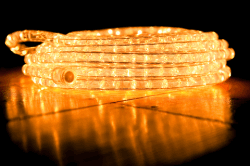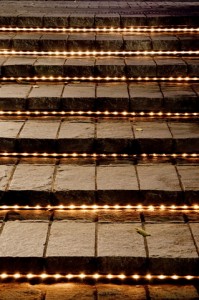LED Outdoor Lighting: Fun and Energy-Efficient Fixtures
LED outdoor lighting provides a wide range of options from colorful decorations to low-energy standard fixtures.
When you think of LED outdoor lighting, you probably think of Christmas lights. While this still their primary use in terms of sheer production, their use in lighting design has changed remarkably over the last ten years. On the one hand, lighting designers have become freer with what is considered “acceptable”, especially in outdoor lighting. The ability of LED light fixtures to shine in multiple colors and to be hung in otherwise awkward locations makes them perfect for the decorative imagination. On the other hand, the development of while LED lighting has created the possibility of simply using LEDs to perform standard outdoor lighting roles, but with easier installation and at greater energy efficiency. In this article, I will discuss the different ways that LED outdoor lighting can contribute to your yard and porch.
Decorative Possibilities

LED rope lights provide for excellent decorative possibilities, highlighting architectural or other stylistic edges.
The problem is that neon signs, circuses and Christmas lights have all given the impression that decorating in light, especially colored light is, well, tacky. However, the medium itself is not tacky, only the uses to which it has been put. In recent years, decorative light has been used to produce beautiful effects in lighting design:
- Decorative light can be used to highlight objects in your yard, especially paths and fountains. These objects tend to disappear at night, even when lit. Decorative lighting allows them to continue to stand out.
- Decorative light can be used for already decorative objects, like gazebos and trellises. Using decorative lighting in this way does not appear “tacky” because they simply bring out the decorative nature of the objects.
- Decorative light can be used to highlight the contours of your landscaping, providing an effect that can only be seen during the night. For example, you could have small ground lights that hug the shape of a hilly area.
None of the above uses will seem tacky. In fact, each of them will provide brightness and excitement to your yard that can only be appreciated at night.
Standard Uses

As they are less susceptible to climate, LED lights can blend in seamlessly, serving as directed lighting.
LED light bulbs are now available to fulfill almost any role that other light bulbs can play. This is because of the development of white, commercially-available light bulbs in the last five years. As a result, any outdoor light, from your porch lights to your path lights can be replaced with LEDs. There is a word of caution, however. The whiteness of LED lights can be difficult to get perfect without paying a premium price at the present moment. The outdoors is especially sensitive to slight variations in light color. Therefore, if you want to use LEDs for standard lighting, you may end up spending some more money.
However, there are some roles that LED outdoor lighting can perform that don’t require a large added expense and to which they actually perform better than other forms of lighting:
Any directed lighting. Directed lighting is light that shines forward in a single direction, rather than in every direction. For years, this market was dominated by halogen light bulbs, but halogen light bulbs are both hot and energy inefficient. This may cause fire hazards and may tax any solar sources of energy that you are using. LED lighting provides directed lighting that is just as high quality. So, if you plan to use lighting that is directed, such as lighting to accent your architecture or to accent elements of your entertaining area, LED outdoor lighting might be the right choice.

LED lights can provide excellent information lighting to assist people with going up stairs at night.
Solar Sources. Solar power can be temperamental. The amount of power that a battery holds can be affected by cold temperatures (something that sometimes isn’t mentioned on the packaging), and the amount of power that is generated depends on weather. As a result, you’ll want to have a large safety margin between the your available solar power and the energy requirements of your light sources. An LED light bulb is an energy-saver light bulb, often saving more than fluorescent lighting, and can be used for such things as post lighting, raised path lighting or any other source of light that you don’t want to hook up to your main power supply.
Putting It All Together
LED outdoor lighting fills quite different roles. On the one hand, it is a wonderful source of decorative illumination, something that was hard to accomplish until recently without looking “tacky”. On the other hand, it provides a source of both directed and low-energy lighting that can be conveniently placed almost anywhere. LED outdoor lighting, therefore, can be an important part of your outdoor lighting design.